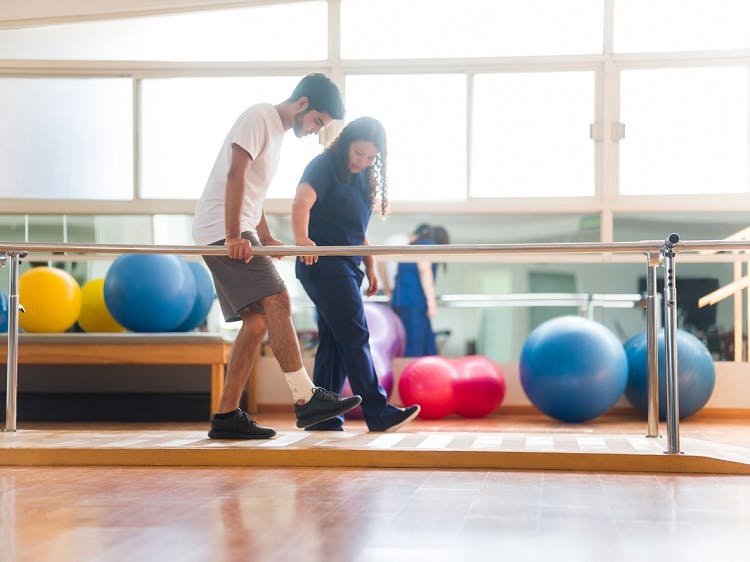Ataxia is a condition that describes impaired balance or coordination. It can be caused by a variety of conditions including traumatic brain injury, cerebral palsy, and stroke. Survivors with ataxia may have difficulty walking or struggle with fine motor coordination, speech, and/or swallowing. Treatment for ataxia varies depending on the part(s) of the body affected, severity and underlying cause.
Please use the links below to jump directly to any section of this article:
What Is Ataxia?
Ataxia is an umbrella term for a group of disorders/neurological diseases that affect coordination, speech, and balance. It typically results from damage to the areas of the brain that control muscle coordination, such as the cerebellum.
Individuals with ataxia typically lose muscle control in different parts of their body, causing difficulty with voluntary movements. Depending on the part of the body affected, ataxia can impair functions such as use of the hands, speech, walking, and eye movements.
Ataxia can be caused by a variety of different factors including neurological diseases such as stroke, TBI, and cerebral palsy. It can also be caused by exposure to certain drugs, or it can be hereditary. It’s important to consult with your doctor and obtain an accurate diagnosis of ataxia in order to receive appropriate treatment.
Underlying Causes of Ataxia
Ataxia may appear suddenly or gradually depending on the underlying cause. For instance, ataxia may appear suddenly when caused by certain injuries or illnesses such as TBI, stroke, infection, or lack of oxygen to the brain.
However, ataxia may also appear gradually when caused by other conditions such as hypothyroidism, excessive alcohol consumption, vitamin deficiencies, multiple sclerosis, tumors, or genetic disorders.
Ataxia can be further divided into three categories: acquired, idiopathic, or hereditary (genetic). The severity of ataxia is influenced by many factors such as the type of ataxia and one’s age at symptom onset.
- Hereditary ataxia refers to a group of degenerative disorders that occur due to a faulty or damaged gene that was passed down by family members. The inherited defective gene codes for abnormal proteins that lead to nerve cell degeneration, which results in ataxia. Symptoms may start in childhood or adulthood and develop slowly over the years.
- Acquired ataxia is caused by external factors such as trauma or infections. Symptoms can develop as a result of damage to the brain or nervous system. Doctors further divide acquired ataxia into different types based on the area of the body most affected, like the cerebellum (cerebellar ataxia) or spinal cord (sensory ataxia).
- Idiopathic ataxia occurs when the brain is progressively damaged over time but doctors cannot determine the root cause. This type of ataxia usually begins in adulthood, and is often not accompanied by any family history.
Though acquired ataxia is the most common, understanding the other types of ataxia can help you distinguish symptoms and seek proper care.
Symptoms of Ataxia
Survivors with ataxia typically experience imbalance, appear clumsy and have poor coordination of the arms, hands, or legs. Symptoms of ataxia can present suddenly or develop over time. Ataxia can also affect different parts of the body.
Other symptoms of ataxia may include:
- Abnormal gait (unsteady manner of walking)
- Slurred speech
- Difficulty swallowing (dysphagia)
- Nystagmus (uncontrolled eye movements)
- Difficulty with fine motor tasks
Symptoms vary and may be unpredictable. Therefore, it’s important to consult with your healthcare provider if you experience any new or recurrent symptoms. They can provide you with a proper diagnosis and treatment plan.
Most Common Types of Ataxia
There are various types of ataxia that can result from damage to the nervous system. Most forms of ataxia cause impaired balance and coordination, but other symptoms may also occur. Understanding the different types can help you differentiate between symptoms.
Seven of the most common types of ataxia that can develop after a neurological injury include:
1. Cerebellar Ataxia
Cerebellar ataxia, as the name suggests, occurs from damage to the cerebellum. This area of the brain helps coordinate movements and balance. Therefore, when the cerebellum sustains damage, survivors may experience impaired balance and loss of coordination. Other symptoms may include changes in the voice, dizziness, fatigue, headaches, or muscle tremors.
2. Sensory Ataxia
Sensory ataxia, also known as proprioceptive ataxia, occurs as a result of damage to the nerves in the spinal cord or peripheral nervous system. This causes the body to receive less feedback from the brain telling it where it is in relation to the ground. Sensory ataxia can cause decreased sensation in the feet and legs, which can cause survivors to walk with a “heavy step” or stomp.
3. Vestibular Ataxia
Vestibular ataxia affects the vestibular system which is located in the inner ear. The vestibular system senses the movements of your head and helps you maintain balance and spatial awareness. When the nerves in the vestibular system are affected, survivors may experience a variety of symptoms such as blurred vision, nausea, vertigo, and staggered movements.
4. Spinocerebellar Ataxia
Spinocerebellar ataxia refers to a genetic type of ataxia that can develop at any age, often progressing slowly. In addition to imbalance and poor coordination, individuals with spinocerebellar ataxia may develop weakness, loss of sensation, and/or eye problems.
5. Episodic Ataxia
With episodic ataxia, individuals typically have recurring issues with movement and balance, resulting in “episodes.” Episodes are often accompanied by muscle twitching/spasms or weakness, dizziness (vertigo), headaches, blurry vision, slurred speech, fatigue, nausea, and/or vomiting. Episodes can also occur multiple times a day or even just one to two times a year, depending on the severity. Episodic ataxia can develop at any age. Although it is hereditary, episodic ataxia can be exacerbated by stress or physical exertion.
6. Friedreich’s Ataxia
Friedreich’s ataxia is the most common type of hereditary ataxia typically caused by damage to the cerebellum, spinal cord, and peripheral nerves. Along with impaired movement, individuals with Friedreich’s ataxia may experience stiff muscles and gradually lose strength and feeling (sensation) in the arms and legs. There can be deformities in the feet such as high arches and sideways curvature of the spine (scoliosis). Other signs may include slurred speech (dysarthria), fatigue, nystagmus, hearing loss, heart enlargement, heart failure, and diabetes.
7. Ataxia-Telangiectasia
Ataxia-telangiectasia, also known as Louis-Bar Syndrome, is a rare inherited condition that typically develops in childhood. Telangiectasia refers to the formation of small “spider” veins that may appear in the corners of the eyes, ears, and/or cheeks. This type of ataxia causes degeneration in the brain and immune system, which increases the risk of developing other diseases such as respiratory infections or tumors.
Common symptoms include delayed motor skill development, difficulty walking, uncoordinated movements, and impaired speech. Another common symptom is the appearance of enlarged or dilated blood vessels known as telangiectasias.
Though these are the most common types of ataxia, there are other types that can develop. Your doctor can discuss your specific type of ataxia with you and administer proper treatment.
Complications of Ataxia
Treating ataxia is important because if left untreated, it can progress and get worse over time. As ataxia progresses, muscles can become less responsive to the commands of the brain. As a result, coordination and balance can worsen and other complications can develop.
Other complications of ataxia may include:
- Spasticity (increased muscle tone)
- Rigidity
- Tremors
- Pain
- Fatigue
- Bowel or bladder dysfunction
- Low blood pressure when sitting and/or standing
Potential complications may vary depending on the specific type of ataxia. While some have only a low risk of developing serious complications, those with severe ataxia can experience difficulty breathing, rigidity, or even choking. Falling or immobility may also increase the risk of further injury, pressure sores, infections, and hematomas (blood clots). To reduce the risk of developing complications, it’s important to obtain proper care in a timely manner.
Treatment for Ataxia
Fortunately, it’s often possible to improve ataxia and prevent it from worsening. Treatment for ataxia depends on the type and cause.
In order to treat ataxia, it is essential to address the miscommunication between the brain and the muscles, which often has been damaged by a neurological injury. This communication can be restored with the help of neuroplasticity, the brain’s ability to rewire itself. Neuroplasticity helps the brain strengthen its communication connections through high repetition of exercises.
Medication may also help improve muscle control, bladder control, heart problems, and eye conditions. However, for many individuals, such as those with cerebellar ataxia or vestibular ataxia, rehabilitation is the most important pillar of treatment. This can include a combination of physical therapy (for mobility), occupational therapy (for daily activities), speech therapy (for speech and swallowing), and regular aerobic exercise (for proper blood circulation).
Therefore, stimulating the brain and activating neuroplasticity is essential in order to restore communication and improve ataxia. This can be accomplished through a variety of different therapeutic exercises.
Physical therapy focuses on helping you improve balance and coordination. Your therapist may provide exercises for the legs and trunk because these muscle groups are often affected by ataxia. However, to maximize your chances of recovery it’s crucial to maintain a proper home exercise program.
Home therapy keeps the brain stimulated and neuroplasticity activated in between your therapy sessions. To boost your motivation to exercise at home, you can use interactive rehab equipment like FitMi home therapy. FitMi was designed to improve full-body mobility. It provides you with exercises based on your ability level and targets specific muscle groups such as the legs and trunk, which can help with ataxia.
Occupational therapy focuses on helping individuals find safe and effective ways to perform their activities of daily living such as eating and bathing. For example, when ataxia affects the ability to use the restroom on your own, an occupational therapist will provide you with compensation techniques, adaptive equipment recommendations, and/or rehabilitation exercises.
Speech and language therapy focuses on helping individuals with impaired speech and difficulty swallowing. Working with a speech-language pathologist is important because they can recognize the different speech conditions caused by ataxia.
The stronger your rehabilitation regimen, the stronger your chances of improving ataxia and lowering the risk of complications. Consult with your doctor or therapist if you experience any new symptoms of ataxia. Early intervention is beneficial to maximize your chances of recovery.
Overcoming Ataxia
Individuals with ataxia experience imbalance and loss of coordination, among other symptoms. Fortunately, ataxia can often improve by treating the root cause. Ataxia is most often caused by damage to the cerebellum from a neurological injury such as a stroke or traumatic brain injury.
If left untreated, ataxia may progress and increase the risk of developing complications. Therefore, obtaining a proper diagnosis is essential to begin treatment. One of the most essential elements for treating ataxia is rehabilitation which can include a combination of physical, occupational, speech, and home therapy exercises.
We hope this article helped you understand how ataxia can develop and the best ways to overcome it.










